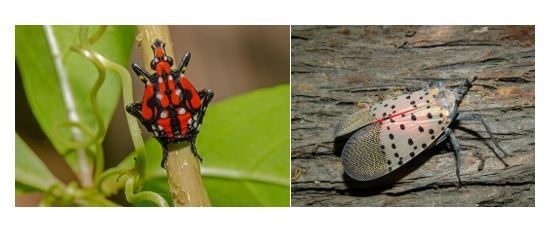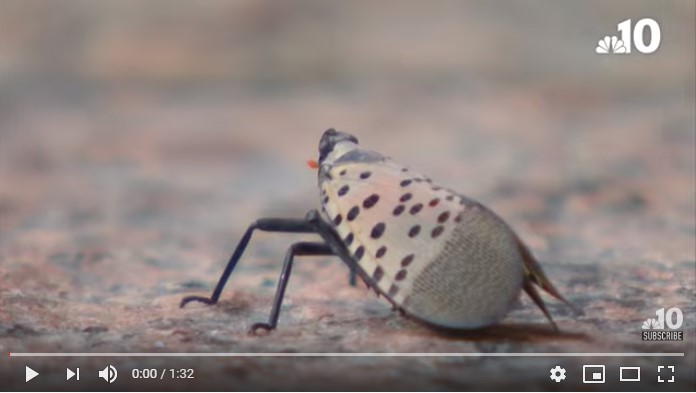
By Dr Tim Haye, Head of Arthropod Biological Control, CABI
In the past two decades, Europe and North America have unintentionally shared many invasive insect pests originating from Asia, including the spotted wing Drosophila (Drosophila suzukii), brown marmorated stink bug (Halyomorpha halys), the box tree moth (Cydalima perspectalis) and Japanese beetle (Popillia japonica). As if that weren’t enough, now there’s a new one on the horizon that may become a global threat to grape production – the spotted lanternfly, Lycorma delicatula.
The up-to-25mm long, very colourful cicada, is native to China, India and Vietnam and was accidentally introduced into South Korea and Japan, with outbreaks reported since mid-2000s. In 2014, this pest was found in Pennsylvania, USA, and has expanded its geographical distribution ever since. The spotted lantern fly feeds on more than 70 plants, but grapes are among its favourites. Throughout the summer adults and nymphs feed on plants by sucking out the sap from leaves, stems or trunks. The sugary excrement created by this insect may coat the host plant, later leading to the growth of sooty mold. The damage has been devastating for the Pennsylvania wine industry, where some growers have reported a 90 percent grape loss due to the new pest.

In late summer the female lanternfly deposits eggs in cluster of 30 to 50 eggs on tree trunks and branches as well as on non-plant structures including bricks, stones, fence posts, vehicles, trailers, and even rail cars. Egg masses laid on outdoor residential items such as those listed above may pose the greatest threat for spreading this insect via human-aided movement. Distribution models based on climate data from the pest’s native range suggest that spotted lanternfly could also establish in the wine growing areas of southern Canada, France, Spain, and Italy. In addition to the risk of direct importation from Asia, the quickly growing populations in the US increase the risk of secondary introductions of egg masses with goods from the US into Europe. Since its preferred Asian host plant, the invasive tree of heaven, is already widespread in Europe, the way for the new invaders is already paved.

To date, the spotted lantern fly has not been reported yet from Europe, but it can’t be excluded that there are already small established population that have remained undetected, particularly in the vicinity of airports, container harbours or train stations, where a potential invasion is more likely to start. Since scientists alone can only monitor small areas for the presence of the pest, a citizen science approach is needed. Citizen science typically refers to research collaborations between scientists and volunteers, particularly to expand opportunities for scientific data collection and to provide access to scientific information for community members. In the case of spotted lanternfly, we would like to ask the European public to keep their eyes open for the colourful, showy nymphs and adults and report any suspicious finds to me at t.haye@cabi.org. If you think you have ‘spotted’ spotted lanternflies in your garden (check your grapes and trees of heaven!), please take a picture with your mobile or digital camera and send it to us for identification.

But how can we prepare for the potential arrival of the pest in Europe? One of the answers could be so called ‘proactive biocontrol’. With this approach, natural enemies of the lantern fly would be selected, screened and pre-approved for release in Europe before the anticipated pest invasion. CABI is currently investigating the natural enemies of spotted lanternfly in China and so far, two parasitic wasps have been identified as potential biological control agents, the egg parasitoid Anastatus orientalis and Dryinus sp., attacking the nymphs of the lanternfly.
Screening these potential natural enemies for their target specificity will be the next step, since in many countries, regulatory requirements have become more prescriptive, and approval for release of any classical biological control agent now requires a thorough risk assessment. Completing the screening before the anticipated arrival of the pest, natural enemies could be released against the spotted lanternfly in Europe at a much earlier point in the emerging management program. Ideally, natural enemies would then significantly reduce pest densities and slow rates of spread, which would lower the economic or environmental damage associated with the pest.
Additional information
Find out more about ‘Proactive biocontrol of spotted lanternfly’ from the project page.
See also the article ‘Predicting the spread of invasive spotted lanternfly’ on the Invasives Blog.
See the news report ‘The Maligned Spotted Lantern Fly Has Made a Home in Philly’ from NBC10 Philadelphia.

Related News & Blogs
CABI contributes to paper focused on pre-emptive benefit-risk assessment of classical biological control agents
CABI has joined an international team of researchers to share their expertise as part of a new paper focused on guidelines and a framework to assess the feasibility of starting pre-emptive benefit-risk assessment of classical biological control agents…
20 December 2023
